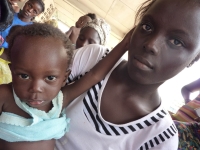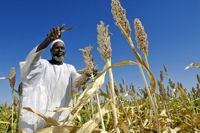Was man created for waging such perpetual "resource wars"?! Who are the consumers, by the way? And what about the arms trade that fuels the slew of armed conflicts going on? Following are two articles on the these themes.
"The evidences of discord...are apparent everywhere, though all were made for harmony and union."
- Baha'i writings
http://is.gd/43qV8
(Excerpts:)
In recent decades, many of the bloodiest conflicts in Africa and Asia have been fuelled by profits from the exploitation of natural resources including diamonds, timber and minerals... [T]here are no formal global mechanisms governing trade in other ......conflict resources like timber, minerals and cocoa.
Since most governments agreed in 2006 on the need to regulate the global arms trade, an estimated 2.1 million people had died as a direct or indirect result of armed violence.
That worked out at more than 2,000 per day, or more than one every minute.
Resource wars
Last reviewed: 30-06-2009
Labourers work at an open-cast diamond mine near Kpetewama, Sierra Leone.
REUTERS/Dylan Martinez
- Millions have died in resource-fuelled wars since the late 1990s
- The Kimberley Process has reduced international trade in conflict diamonds
- Campaigners want legally enforceable rules for oil and mining companies
Trade in "blood diamonds" provided vital funding for warlords and rebels fighting civil wars in Angola, Sierra Leone and Liberia in the late 20th century. After this was exposed, pressure grew for an international mechanism to stop this trade, thereby cutting off cash for arms purchases and helping end conflicts. The Kimberley Process - a scheme to certify the source of diamonds - was launched in 2003, and is credited with reducing the proportion of conflict diamonds in international trade to below 0.5 percent. Most of the worst resource-fuelled wars in recent years have ended. But activists warn that, without greater efforts to make international trade more ethical, history could repeat itself. Besides the Kimberley Process for diamonds, there are no formal global mechanisms governing trade in other conflict resources like timber, minerals and cocoa. Advocacy group Global Witness says a first step would be to reach an internationally agreed definition of what they are. Campaigners also want legally binding rules to govern the conduct of multinational oil and mining companies, which they accuse of indirectly contributing to human rights abuses. Most major corporations have signed up to voluntary schemes, but critics say they lack teeth.
Source:
http://www.alertnet.org/db/crisisprofiles/conflictresources.htm
07 Oct 2009 00:01:00 GMT Source: Reuters
* An estimated 2.1 million people killed since 2006
* Groups call for treaty in 2012 regulating arms trade
* U.S. Bush administration opposed past treaty efforts
By Patrick Worsnip
UNITED NATIONS, Oct 6 (Reuters) - More than 2,000 people around the world are dying from armed violence each day, on average, advocacy groups said on Tuesday, urging nations to launch negotiations on a treaty to regulate the arms trade.
A report by the 12 groups was issued as a U.N. General Assembly committee began considering a draft resolution that would set a timetable for negotiations with the aim of concluding a treaty in 2012.
The report, written for the groups by British-based Oxfam, said that since most governments agreed in 2006 on the need to regulate the global arms trade, an estimated 2.1 million people had died as a direct or indirect result of armed violence.
That worked out at more than 2,000 per day, or more than one every minute - most of them civilians.
Of the deaths, more than 700,000 resulted from armed conflicts, including those in Afghanistan, Somalia, Sudan, Sri Lanka and the Democratic Republic of the Congo, the report said. The figures also include people killed in non-political violence involving firearms.
Oxfam executive director Jeremy Hobbs said eight out of 10 governments wanted agreement on an arms trade treaty.
"This month we want the majority of enlightened countries at the U.N. to make it happen," Hobbs said in a statement. "An intransigent few cannot be allowed to keep their foot on the brakes forever."
The proposed legally binding treaty would tighten regulation of, and set international standards for, the import, export and transfer of conventional weapons.
Supporters say it would give worldwide coverage to close gaps in existing regional and national arms export control systems that allow weapons to pass onto the illicit market.
Nations would remain in charge of their arms export control arrangements but would be legally obliged to assess each export against criteria agreed under the treaty. Governments would have to authorize transfers in writing and in advance.
CONCERNS ON EFFECTIVENESS
The main opponent of the treaty in the past was the U.S. Bush administration, which said national controls were better. Last year, the United States accounted for more than two-thirds of some $55.2 billion in global arms transfer deals.
Arms exporters China, Russia and Israel abstained last year in a U.N. vote on the issue.
The proposed treaty is opposed by conservative U.S. think-tanks like the Heritage Foundation, which said last month that it would not restrict the access of "dictators and terrorists" to arms but would be used to reduce the ability of democracies such as Israel to defend their people.
The U.S. lobby group the National Rifle Association has also opposed the treaty.
Diplomats said the Obama administration was more open than its predecessor to a treaty, but still had concerns about its effectiveness and whether it could affect U.S. citizens' rights to bear arms. Treaty supporters say it would not regulate domestic arms sales.
The resolution before the General Assembly is sponsored by seven nations including major arms exporter Britain. It calls for preparatory meetings in 2010 and 2011 for a conference to negotiate a treaty in 2012.
Haggling over the text is due to continue until a vote in the assembly's first committee, which deals with disarmament, in the last week of October. The resolution would then go to the full assembly in December.
(Editing by Eric Beech)
Source:
http://alertnet.org/thenews/newsdesk/12549000465.htm










